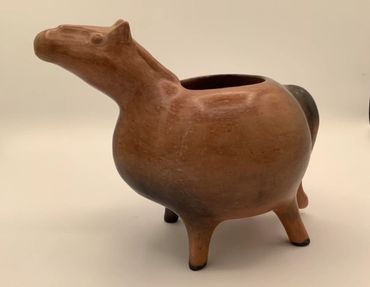What is catawba pottery?

History
Catawba pottery has been the lifeblood of the Catawba Nation for thousands of years. It sustained our people through some of the most difficult chapters in our history. When settlers arrived in the Carolinas, Catawbas sold pottery along growing trade routes. During the Great Depression, Catawba women used their skills to help families survive. Today, Catawba pottery is celebrated as a distinct and respected form of Native American art.
Pieces made by Catawba artists have been featured in museums across the United States—including the Smithsonian—and internationally, in institutions like the Louvre in Paris and other European museums.
Our people have practiced this tradition for at least 4,000 years—some scholars say as many as 6,000. And throughout that time, not a single generation has let the tradition fade. Catawba pottery reaches to the very heart of who we are. While the loss of our language and other cultural practices has deeply impacted our community, the loss of our pottery tradition would be even more devastating. It remains one of the few living traditions that continues today—unbroken.
Traditional Methods, Time-Honored Craft
Catawba pottery is still made using the same hand-built methods our ancestors used. In an article about Georgia Harris—our Foundation’s namesake and one of the most influential Catawba potters—she described her process:
She gathered clay from the riverbanks near her home in Rock Hill, South Carolina. She would start by patting the clay into a flat shape, rolling it into coils, and stacking those coils to form a vessel.
“You have to get it wet enough,” she said, “’cause if they crack, that’s usually trouble.”
After forming the pot, she allowed it to dry, then re-wet the surface to scrape and polish it smooth with stones—creating the signature soft, velvet-like finish. Sometimes, she carved designs or added sculptural handles shaped like turtles or other animals.
“A long time ago, they used to paint the surfaces,” she said, “but they never put glaze on them.”
The traditional firing process involves burying the pots in open pit fires, which give the pottery its rich, multicolored tones—from deep oranges to blacks.
“I might use some soft woods to start it off with, but when you want to burn them real good, hard wood is better. I’ve always found that it’s better. It holds heat longer. Makes it burn faster.”
A Living Connection
Catawba pottery is more than an art form. It is our connection to who we are as a people.
In today’s world—where technology distracts and time is scarce—it's easy for younger generations to feel disconnected. But when we do take the time to slow down, to learn, and to put our hands in the clay, we find something powerful: a deep, instinctual pull toward our traditions.
That connection may be the only explanation for why no generation of Catawba people has ever stopped making pottery. And through the work of the Georgia Harris Foundation, we intend to ensure that no generation ever will.
Portions of this biography were adapted from the NEA website: https://www.arts.gov/honors/heritage/georgia-harris
The artistry of Catawba Pottery



This website uses cookies.
We use cookies to analyze website traffic and optimize your website experience. By accepting our use of cookies, your data will be aggregated with all other user data.